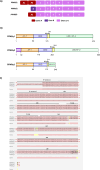Familial partial lipodystrophy resulting from loss-of-function PPARγ pathogenic variants: phenotypic, clinical, and genetic features
- PMID: 39398333
- PMCID: PMC11466747
- DOI: 10.3389/fendo.2024.1394102
Familial partial lipodystrophy resulting from loss-of-function PPARγ pathogenic variants: phenotypic, clinical, and genetic features
Erratum in
-
Corrigendum: Familial partial lipodystrophy resulting from loss-of-function PPARγ pathogenic variants: phenotypic, clinical, and genetic features.Front Endocrinol (Lausanne). 2024 Dec 3;15:1508146. doi: 10.3389/fendo.2024.1508146. eCollection 2024. Front Endocrinol (Lausanne). 2024. PMID: 39691315 Free PMC article.
Abstract
The PPARG gene encodes a member of a nuclear receptor superfamily known as peroxisome proliferator-activated gamma (PPARγ). PPARγ plays an essential role in adipogenesis, stimulating the differentiation of preadipocytes into adipocytes. Loss-of-function pathogenic variants in PPARG reduce the activity of the PPARγ receptor and can lead to severe metabolic consequences associated with familial partial lipodystrophy type 3 (FPLD3). This review focuses on recent scientific data related to FPLD3, including the role of PPARγ in adipose tissue metabolism and the phenotypic and clinical consequences of loss-of-function variants in the PPARG gene. The clinical features of 41 PPARG pathogenic variants associated with FPLD3 patients were reviewed, highlighting the genetic and clinical heterogeneity observed among 91 patients. Most of them were female, and the average age at the onset and diagnosis of lipoatrophy was 21 years and 33 years, respectively. Considering the metabolic profile, hypertriglyceridemia (91.9% of cases), diabetes (77%), hypertension (59.5%), polycystic ovary syndrome (58.2% of women), and metabolic-dysfunction-associated fatty liver disease (87,5%). We also discuss the current treatment for FPLD3. This review provides new data concerning the genetic and clinical heterogeneity in FPLD3 and highlights the importance of further understanding the genetics of this rare disease.
Keywords: PPAR gamma; adipose tissue; diabetes mellitus; genetic lipodystrophy; insulin resistance.
Copyright © 2024 Soares, da Silva, Campos and Lima.
Conflict of interest statement
The authors declare that the research was conducted in the absence of any commercial or financial relationships that could be construed as a potential conflict of interest.
Figures



References
Publication types
MeSH terms
Substances
LinkOut - more resources
Full Text Sources

